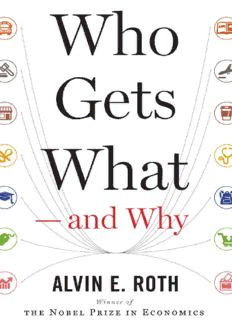
Who Gets What — and Why: The New Economics of Matchmaking and Market Design PDF
Preview Who Gets What — and Why: The New Economics of Matchmaking and Market Design
Contents Title Page Contents Copyright Dedication Acknowledgments MARKETS ARE EVERYWHERE Introduction: Every Market Tells a Story Markets for Breakfast and Through the Day Lifesaving Exchanges THWARTED DESIRES: HOW MARKETPLACES FAIL Too Soon Too Fast: The Greed for Speed Congestion: Why Thicker Needs to Be Quicker Too Risky: Trust, Safety, and Simplicity DESIGN INVENTIONS TO MAKE MARKETS SMARTER, THICKER, AND FASTER The Match: Strong Medicine for New Doctors Back to School Signaling FORBIDDEN MARKETS AND FREE MARKETS Repugnant, Forbidden . . . and Designed Free Markets and Market Design Notes Index About the Author Copyright © 2015 by Alvin E. Roth All rights reserved For information about permission to reproduce selections from this book, write to Permissions, Houghton Mifflin Harcourt Publishing Company, 215 Park Avenue South, New York, New York 10003. www.hmhco.com Library of Congress Cataloging-in-Publication Data is available. ISBN 978-0-544-29113-3 Jacket design by Martha Kennedy Jacket art © Getty Images Author photograph © Economics Department, Stanford University eISBN 978-0-544-28839-3 v1.0515 To Ben and Aaron, Emilie, and Ted Acknowledgments Market design is a team sport, so I owe a great debt to all those who have worked on the markets reported here, many of whom are named in the course of telling the story. It turns out that making a book is also more of a team sport than I imagined. I received lots of help on this book, and would have received more if I were easier to help. Worth special mention are my agent, Jim Levine; Tim Gray, who conducted interviews of participants in kidney exchange and school choice; Mike Malone, who made my paragraphs shorter and clearer (and who knows a lot about Sooners); and my publisher, Eamon Dolan, who had clear ideas about what should be included in the book and what should not. I’m also indebted to Barbara Jatkola for thoughtful copyediting, and to Atila Abdulkadiroğlu, Eric Budish, Neil Dorosin, Alexandru Nichifor, and Parag Pathak for careful reading and insightful comments. PART I MARKETS ARE EVERYWHERE 1 Introduction: Every Market Tells a Story IT WAS 5:00 a.m. on an April morning in 2010. Eight teams of surgeons were preparing to operate on eight patients in four different cities. Four healthy people would each be donating one of their kidneys to someone they had never met, and those four recipients, each suffering from end-stage renal disease, would receive a new lease on life. At the same time, Jerry and Pamela Green were at their kitchen table in Lincoln, Massachusetts, studying the weather. They were soon to fly as volunteers, in their own small airplane, to Lebanon, New Hampshire, to pick up one of those kidneys, take it to Philadelphia, pick up another kidney there, and take it to Boston. (Two other pilots would transport the other two kidneys.) Because they identified their flight with the call sign “Lifeguard,” signifying medical urgency, the air traffic controllers would take them, no questions asked, right through one of the world’s busiest airspaces, down the Hudson River and over Newark airport, on their way to Philadelphia, where they would be scheduled to land immediately. Several jetliners carrying hundreds of passengers would be briefly delayed by their passage. Kidneys for transplantation are scarce. So is airspace: an airliner uses several hundred dollars per minute in fuel, and only one airplane can occupy a given block of airspace at a time. Passengers’ time is also costly. Who got which kidney, which operating room, and which flight path that day in April all required an allocation of scarce resources, so it is perhaps fitting that when Jerry is not flying a small plane, he is a professor of economics at Harvard. Economics is about the efficient allocation of scarce resources, and about making resources less scarce. Those kidneys and flights weren’t the only scarce resources that had been allocated to bring everything together on that day when four lives were saved. Years earlier, each surgeon had been admitted to medical school and then had proceeded through surgical residencies and fellowships. At each stage, they’d competed with other aspiring physicians. Jerry himself had to go through a similar set of competitions to get his job. Before embarking on their professional training, Jerry and the surgeons had been admitted to colleges, and before that Jerry had been admitted to Stuyvesant, New York City’s most selective public high school. Notice that none of these things—kidneys, places in competitive
Description: